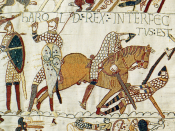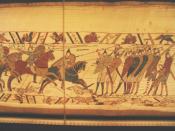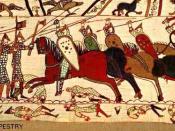At around 9.00, William's three divisions began their slow advance up the ridge towards the Saxon line. As the thin line of archers came within range, they loosed their volleys of arrows until their supply was exhausted. This attack was ineffectual in thinning the Saxon line as hoped as firing uphill, most arrows were expended on the shield wall or sailed harmlessly overhead. This attack may have been over quicker than William had intended. There would have been few arrows to be reused as the Saxons had few archers with which to reply. Once their quivers were emptied, the Norman archers would have to wait for new supplies to be brought up from the rear.
As they fell to the rear, the infantry began their struggle up the slope. Coming within range, they were met by a murderous assault of spears, axes and stones tied to sticks causing numerous casualties.
Due to the shallower slope they faced, the Bretons arrived at the Saxon line before the other divisions, unsupported on their flanks and closely followed by an uncoordinated attack by their cavalry. As they came against the intact shield wall, the Saxons threw themselves forward and broke the Breton attack, routing them. As they fled, the Norman center division was attacked on its now open flank forcing a disorderly retreat.
A section of the Saxon line pursued the Bretons, probably against Harold's orders. It is likely that the less disciplined fyrdsmen did so, the Beaux tapestry showing them as unarmored. It is often said that if Harold had ordered an all out attack at this stage, he may have routed the Normans from the field entirely but this is unlikely. His only advantage was in static defense behind his shield wall. Attacking cavalry was forced to turn the unprotected flanks...


